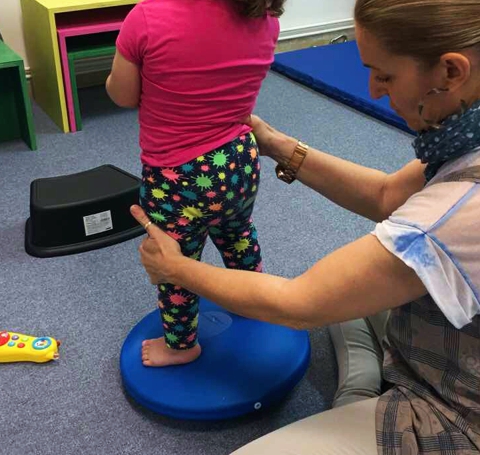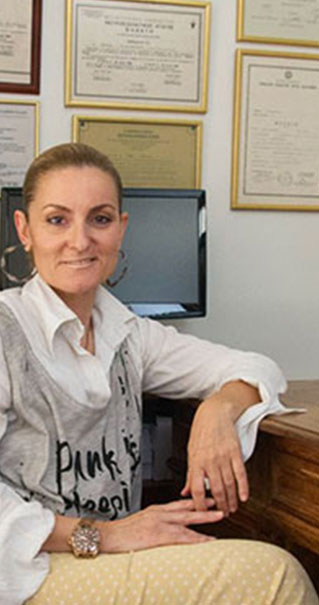The motor control is being determined mainly by three sensory sub-systems of central nervous system: the vestibular system, the proprioceptive system and the visual system[1,5]. The above mentioned systems are working together to maintain our balance by dynamically adapting our posture and walking in any needed way under every circumstance, a process called motor learning[1,2]. The successful effort of moving toward a place, meets specific capabilities such as the ability to move toward a goal and adapting effectively to the conditions of space and environment simultaneously[9]. Adapting to a space is a slow process and refers to the changes that are taking places inside the three sensory systems at the time of motor learning. Self-caring, in order to be effective and sufficient, except of moving in upright position also premises the ability of moving through different functional positions[2].
The importance of visual perception in the development of sufficient motor control has been underlined in numerous papers[1,3]. Poor visual perception has a negative effect in motor development, postural adaptation, and moving behavior since motor-visual system is responsible of organizing the muscle synergies towards successful system. In loss of vision, the proprioceptive system leads the relocation of body mass center and movement coordination[4]. The motor coordination system is capable of forming stable motor patterns in order to complete certain functions through the close connected proprioceptive, perceptive and motor functions[1,3]. The visual systems is responsible for redefining motor planning in case a visual change would take place so motor condition would adapt via Proprioceptive and motor system[1,11].
The visual, motor and proprioceptive systems are responsible for successful, optional and mature functional motor planning[1,6]. This happens through developing connected structures between the above mentioned systems[1,5]. These structures are part of strategic importance of functional planning and are being developed in specific motor patterns for specific functional motor tasks[1,4,6]. In case of an unsuccessful effort to perform a specific function due to visual misinformation, the motor and proprioceptive system cooperates to provide the necessary sensory information for a successful motor task[1,5,6].
Postural control varies over time, adapting to new data through the brain development. The training of postural and kinetic control will benefit the results of this adaptation procedure[10]. Neurological mechanisms adjust to visual perception of space, making it a great tool in neurorehabilitation[1,10]. Throw this adaptation is possible direct effects, on the visual and motor system as well as attentive attention and high cognitive neurological function, to take place[1,9].
In neurorehabilitation, the incorporation of visual perception of space has impressive results in improving the motor functional therapeutic tasks and is done through prisms’ adaptation[2].
Prisms are three leveled transparent glass pyramids, which have a base and a top[6]. They can be placed in pairs fitted to special rotating spectacle frames to change the person’s visual orientation in space[3]. As the visual orientation is influenced, the perception of space is also influenced in a way that changes to postural tone, postural balancing reactions and to the balance itself, take place[1,3].
Through the prisms, the perception of the body’s midline changes resulting in change to the proprioceptive feedback from the support base throughout the body, aligning the head-neck-torso and limbs, which reorganizes the body’s postural control to the new visual perception[1,8]. This reorganization can reorganize the middle sift of postural control by influencing visual and vestibular system. Using prisms we can improve the quality in daily activities like balance on standing position, reading, wheel chair riding[10].
The strategic patterns relate to the ability to interface and interact with sensory systems to receive, process and organize sensory information, resulting in the perception of a reasonable world[1]. For every movement, the visual motor information associated with the particular movement is encoded into a motor strategic pattern able to be recalled every time the person is in a position to start a functional task in which the particular movement is included[1,2]. At the level of strategic organizational control it appears that prism adaptation causes a difference between visual and proprioceptive orientation. This visual disorientation can in fact reorient and realign the body causing changes to proprioceptive system and body image as well[10].
The adjustment of postural control, the strategic organizational control and the space perception reorganization are the parameters of the sensory sub-systems that cause the motor performance during orientation through prism adaptation[11]. The kinesthetic asymmetry caused by prisms adaptation is capable of producing changes in both perception of body image and postural control[3].
Conclusion
Visual system training may improve functional visual tasks in children and adults patients with motor impairments by incorporate it into the rehabilitation program. In lack or impairment of postural control visual system can change the perception of body image and can be used as the key system to reorganize and regain postural control through prism adaptation
Bibliography
- Aikaterini Ziaka. The influence of the application of prisms on body stance changes, during gait and rise from sitting, in normal children, age 7-10 years. University of Thessaly, Dept of Phys. Edu & Sport Sci.
- Bedford FL. Perceptual learning. In D. Medin (Ed.), Psychology of learning and motivation: Advances in research and theory 1993b; 30:1-60
- Benabib RM. Use of rotary prism as a modality during physical handling. e-Journal home. 2007; 2:3
- Farné A, Rossetti Y, Toniolo S, Ladavas E. Ameliorating neglect with prism adaptation: visuo-manual and visuo-verbal measures. Neuropsychologia 2002; 40(7): 718-729.
- Gottshall KR, Hoffer ME, Cohen HS, Moore RJ. Active movements facilitate compensation for effects of prism displacement on dynamic gait. Journal of Vestibular Research 2006; 16:29-33
- Huitema RB, Brouwer WH, Mulder T, Dekker R, Hof AL et al. Effect of ageing on ability to adapt to a visual distortion during walking. Gait and posture 2005; 21:440-446
- Luauté J, Michel C, Rode G, Pisella L, Jacquin-Courtois S, Costes N, Cotton F, le Bars D, Boisson D, Halligan P, Rosseti Y. Functional anatomy of the therapeutic effects of prism adaptation on left neglect. Neurology. 2006; 66(12):1859-1867
- Pisella L, Robe G, Farné A, Tilikete C, Rossetti Y. Prism adaptation in the rehabilitation of patients with visuo-spatial cognitive disorders. Current Opinion in Neurology 2006; 19: 534-542
- Redding GM, Wallace B. Generalization of prism adaptation. Journal of Experimental Psychology: Human Perception and Performance. 2006; 32(4): 1006-1022
- Redding GM, Rossetti Y, Wallace B. Applications of prism adaptation: a tutorial in theory and method. Neurosience and Biobehavioral Reviews 2005; 29:431-444
- Tilikete C, Robe G, Rossetti Y, et al. Prism adaptation to rightward optical deviation improves postural imbalance in left-hemiparetic patients. Curr. Biol. 2001; 11:524-528

